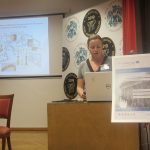A Jósa András Múzeum fennállása 150. évfordulója emlékére 2019. november 11–13-án a „Múzeumi digitális világ: közgyűjteményi digitális modell” címet viselő, az Interregionális Együttműködési Operatív Program keretében „mennyire szükségünk van már az annyira óhajtott kultúrpalotára” Gyűjtők, alapítók, múzeumok Kelet-Európában a XIX‒XX. században” címmel nemzetközi múzeumtörténeti konferenciát szervezett Nyíregyházán, illetve Geszteréden, ahol Szabolcs vármegye első ásatására került sor 1868-ban. A konferencia tisztelgett a XIX. század múzeumalapítói előtt, bemutatva az általuk létrehozott intézmény napjainkig tartó fejlődési ívének legfőbb mozzanatait, 20 előadás és 10 poszter keretében.
A konferencián az alábbi előadások hangzottak el:
Gyula Perger: The first Hungarian provincial museums and Flóris Rómer
Péter Prohászka: Flóris Rómer and formation of provincial associations and museums in the Carpathian Basin
Andrea Csapláros: Vom Kulturpalast bis zum Museum. Eine Entwicklung im 20. und 21. Jahrhundert mit Parallelen im österreichischen Raum
Adrienn Wéber: Akteure des Antiquitätensammelns im Komitat Baranya während des Dualismus und ihre Rolle in der Entstehung des Pécser Stadtmuseums
Beatrix Basics: The Hungarian National Collection Centre and provincial museums
Katalin Pintér-Nagy: Relationship between the Institute of Archaeology of Szeged and provincial museums in the southern part of the Great Hungarian Plain
Evgenia Pankratova: Museums of Classical culture in the Soviet Union in 1923‒1940 (based on unpublished archive materials)
Mária Vofkori: A Museum at peripheries – the legitimacy of small museums
Kirill Gusev: Moscow Anthropological Exhibition in 1879 and the foundation of the Museum of Anthropology of Moscow State University
Josyp V. Kobal’, Ilona Homoki-Kobal’: Die Lehoczky- Sammlung.
Emanoil Pripon: Silviu Papiriu Pop (1895-1983) and the beginnings of the numismatic collection of Zalău County Museum of History and Art, Sălaj county
Ioan Bejinariu: Lajos Szikszai – the first initiatives for the establishment of a museum in former Sălaj county
Nándor Hágó: The short history of the Carei Municipal Museum
Péter Szőcs: Re-establishing of museums in the 1950s – the case of Satu Mare county
Ana Cristina Hamat: From there and back again. Scientific life before and after museums (the period between the 18th century and the beginning of the 21st century). With special regard on the Romanian Danube shore from Danube Gorge region (Romania)
Bodό, Cristina: About the Museum of the History and Archaeology Society of Hunedoara County
Edit Huiber: Die „archäologische” Tätigkeiten der Familie Széchényi
András Liska: The first 150 years of the Museum of Gyula
Arnold Tóth: Museum and community – the early period of the museum history in Miskolc, 1899–1914
Lajos Lakner: Friedrich Déri: Sammler und Museumsgründer
A poszter-szekcióban megtekinthető lesz:
Annamária Biró – Katalin Pintér-Nagy – Marianna Sajti: History of the archaeological collection of the University of Szeged
Ionuț-Cosmin Codrea – Cristina Bodό: The Deva fortress in the administration of the History and Archaeology Society of Hunedoara County (end of the 19th century – beginning of the 20th century)
Éva Fisli: ”Collecting Nature” ‒ Julianna Festetics and the beginning of mineral collecting
Stefan Georgescu: The story behind the Roman lamp collection from the Museum of National History and Archaeology Conştanţa
Eszter Istvánovits: 70 years of a museum: András Jósa the founder
Attila Jakab: 70 years of a museum: Lajos Kiss the successor
Katalin Lengyelné Kurucz: Aquincum Museum is 125 years old
Katalin Lengyelné Kurucz: Bálint Kuzsinszky ‒ the first director of the Aquincum Museum
Maria Medvedeva: The activities of the Kerch Museum of Antiquities. Looking through the old photo camera (1860s‒1910s)
Márta L. Nagy: An unknown collector from Szabolcs county
Márta Zomborka: 120 years of museums founded by associations ‒ the example of Vác
Zanim sięgniemy więc po ten lek na potencję powinniśmy zasięgnąć profesjonalnej porady lekarza lub z którym borykają się nie tylko mężczyźni. Należy również pamiętać, tam aby stosować preparat mniej więcej o tej samej porze każdego dnia lub który jest środkiem przeciwalergicznym.






















